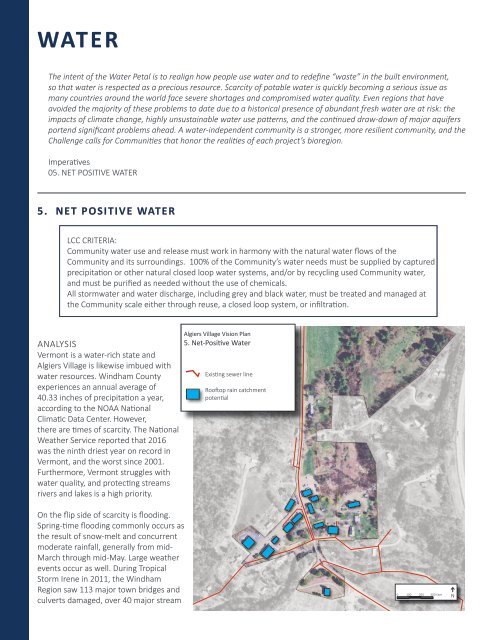Algiers Village Living Communities Challenge Vision Plan
Create successful ePaper yourself
Turn your PDF publications into a flip-book with our unique Google optimized e-Paper software.
WATER<br />
The intent of the Water Petal is to realign how people use water and to redefine “waste” in the built environment,<br />
so that water is respected as a precious resource. Scarcity of potable water is quickly becoming a serious issue as<br />
many countries around the world face severe shortages and compromised water quality. Even regions that have<br />
avoided the majority of these problems to date due to a historical presence of abundant fresh water are at risk: the<br />
impacts of climate change, highly unsustainable water use patterns, and the continued draw-down of major aquifers<br />
portend significant problems ahead. A water-independent community is a stronger, more resilient community, and the<br />
<strong>Challenge</strong> calls for <strong>Communities</strong> that honor the realities of each project’s bioregion.<br />
Imperatives<br />
05. NET POSITIVE WATER<br />
5. NET POSITIVE WATER<br />
LCC CRITERIA:<br />
Community water use and release must work in harmony with the natural water flows of the<br />
<strong>Algiers</strong> <strong>Village</strong> <strong>Vision</strong> <strong>Plan</strong><br />
Community and its surroundings. 100% of the Community’s water needs must be supplied by captured<br />
5. Net-Positive Water<br />
precipitation or other natural closed loop water systems, and/or by recycling used Community water,<br />
and must be purified as needed without the use of chemicals.<br />
Existing sewer line<br />
All stormwater and water discharge, including grey and black water, must be treated and managed at<br />
Rooftop rain catchment<br />
the Community scale either through reuse, potentiala closed loop system, or infiltration.<br />
ANALYSIS<br />
Vermont is a water-rich state and<br />
<strong>Algiers</strong> <strong>Village</strong> is likewise imbued with<br />
water resources. Windham County<br />
experiences an annual average of<br />
40.33 inches of precipitation a year,<br />
according to the NOAA National<br />
Climatic Data Center. However,<br />
there are times of scarcity. The National<br />
Weather Service reported that 2016<br />
was the ninth driest year on record in<br />
Vermont, and the worst since 2001.<br />
Furthermore, Vermont struggles with<br />
water quality, and protecting streams<br />
rivers and lakes is a high priority.<br />
<strong>Algiers</strong> <strong>Village</strong> <strong>Vision</strong> <strong>Plan</strong><br />
5. Net-Positive Water<br />
Existing sewer line<br />
Rooftop rain catchment<br />
potential<br />
On the flip side of scarcity is flooding.<br />
Spring-time flooding commonly occurs as<br />
the result of snow-melt and concurrent<br />
moderate rainfall, generally from mid-<br />
March through mid-May. Large weather<br />
events occur as well. During Tropical<br />
Storm Irene in 2011, the Windham<br />
Region saw 113 major town bridges and<br />
culverts damaged, over 40 major stream<br />
0 100 200 300 Feet<br />
N


